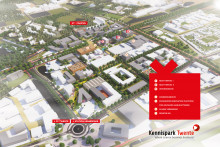The crossing will be located near the Spiegel on one side and the Institutenweg on the other side of the Hengelosestraat. ‘The municipality has given the order and the preparatory work has just started’, says project manager Alfred Stobbelaar. ‘We expect this project to be completed by May at the latest.’
‘It will be a wide, square-like crossing, where a bus stop will also be located’, continues Stobbelaar. ‘Around it, meeting rooms will be placed to encourage people from the UT and the Business & Science Park to meet each other.’ Meeting each other is crucial, he says. ‘That is, in a nutshell, the foundation of the area strategy; that we are moving from two relatively separate areas to one. A UT student cannot spend five years here while never having crossed the Hengelosestraat.’
No right of way
The Hengelosestraat is currently a busy and, above all, a wide traffic artery between Enschede and Hengelo. Those who want to cross the road on foot or by bicycle also have to wait a long time. ‘If you include the bus lane, you have eight lanes that you have to cross. At the crossing, we will reduce that to two lanes, each in one direction. With a double bus lane in between’, says Stobbelaar.
However, pedestrians and cyclists do not have the right of way on the crossing, he emphasizes. There are no crosswalks or traffic lights. Car traffic, therefore, has right of way.' But according to the project manager, traffic safety will not be compromised. ‘A traffic engineer has looked at it and we have already tested it by crossing the road several times. The traffic lights at the main entrance of the UT and at hotel De Broeierd regulate the flow and provide enough quiet moments to cross the road.'
Residencies, parking garage and collection buildings
More changes are in the pipeline around the Hengelosestraat, current interim area director Marieke Stokkelaar adds. ‘There are plans for a second crossing, at The Gallery,’ she says. ‘The Fraunhofer Project Center is currently being built on the Hengelosestraat. In addition, there are plans to construct several buildings near the first crossing: a parking building, two multi-company buildings with the name NEXT Twente and a residential building with two hundred homes for PhD candidates, young professionals and employees of Kennispark companies.'
Stokkelaar expects the permits to be completed by the end of this year at the latest. ‘These projects are in line with the aim of turning the strip along Hengelosestraat into a so-called innovation district. We are strongly aiming for a sharper high-tech profile for Kennispark Twente. Promising clusters such as MedTech and Chip Design, but also Materials and Advanced Manufacturing require buildings and facilities that strengthen the innovation ecosystem.’
Contours visible
According to the area director and project manager, the contours of the new Kennispark will become increasingly visible in 2023. ‘The area was created in the 1980s and 1990s, with plots, buildings and an adjacent parking lot for each building. We’re letting go of that idea and – following the example of the university – we move to a campus-like environment, with many shared facilities,' says Stobbelaar.
According to him, the goals are threefold: ‘We want to offer an attractive place for talent, who are currently still leaving the region in large numbers. If we succeed, it will help the companies we have to grow. And the third goal is that companies from further away know how to find their way to Kennispark.'






